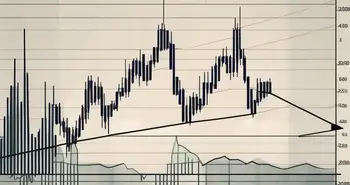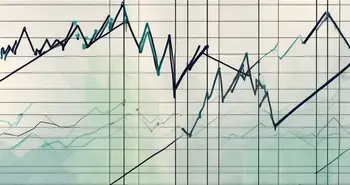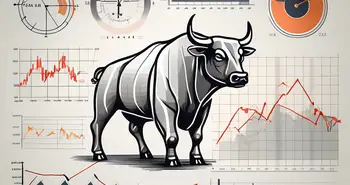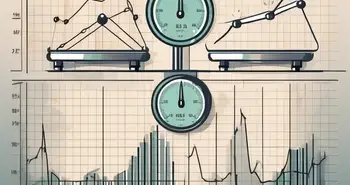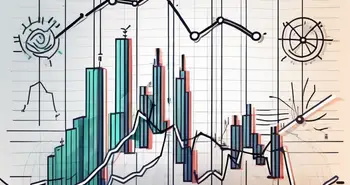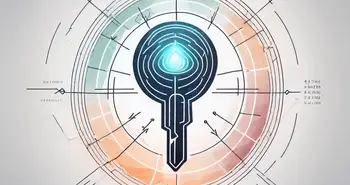The Impact of Triangles in Trading: A Comprehensive Analysis

Trading is a complex arena where every decision can have a significant impact on your success or failure. In this comprehensive analysis, we will explore the crucial role that triangles play in trading and how they can be used to enhance your strategies. Triangles have long been a favorite tool of traders, as they provide valuable insights into price movements, risk management, and trade entry and exit points. Understanding the different types of triangles and how to effectively utilize them can make a substantial difference in your trading performance.
Understanding the Basics of Triangles in Trading
In order to fully grasp the impact of triangles in trading, it is essential to first understand the basics of what triangles are and how they function in the context of trading. A triangle is a chart pattern that consists of two converging trendlines, creating a triangle-like shape on the chart. These trendlines connect the swing highs and swing lows of the price action, forming a pattern that suggests a period of consolidation ahead of a potential price breakout.
When analyzing triangles in trading, it is important to consider the psychology behind this pattern. Triangles represent a temporary balance between buyers and sellers, as the price consolidates within the converging trendlines. This consolidation phase often occurs after a significant price move, indicating a pause in the market as traders reassess their positions and await further price direction.
Defining Triangles in the Context of Trading
Triangles in trading are often referred to as consolidation patterns. They occur when the price movement tightens within the converging trendlines, indicating a decreasing range between highs and lows. This narrowing range signals a battle between buyers and sellers, with neither side gaining a clear advantage. As a result, the price consolidates and forms a triangle pattern.
During this consolidation phase, traders closely monitor the price action within the triangle, looking for signs of a potential breakout. The longer the consolidation period, the more significant the potential breakout can be. This is because a prolonged period of indecision often leads to a surge in buying or selling pressure once the price breaks out of the triangle.
The Three Types of Triangles: Ascending, Descending, and Symmetrical
There are three main types of triangles that traders commonly encounter: ascending triangles, descending triangles, and symmetrical triangles. Each type has its own characteristics and potential implications for price movements.
An ascending triangle is characterized by a horizontal upper trendline and a rising lower trendline. This pattern suggests that the buyers are becoming more aggressive and may eventually overwhelm the sellers, leading to a potential upside breakout. Traders often look for a confirmation of the breakout by monitoring the volume, as an increase in volume during the breakout can provide further validation of the bullish move.
On the other hand, a descending triangle has a horizontal lower trendline and a declining upper trendline. This pattern indicates that the sellers are gaining control and may push the price lower, resulting in a potential downside breakout. Similar to ascending triangles, traders pay attention to the volume during the breakout to confirm the bearish move.
Symmetrical triangles, as the name suggests, have both trendlines converging at an equal angle. This pattern represents a period of indecisiveness in the market, with buyers and sellers in near equilibrium. Traders often look for a breakout in either direction as a signal for the next significant price move. The breakout direction can provide insights into the future trend, with a bullish breakout suggesting a potential uptrend and a bearish breakout indicating a potential downtrend.
When trading triangles, it is important to consider other technical analysis tools and indicators to increase the probability of successful trades. Traders often combine triangle patterns with support and resistance levels, moving averages, and oscillators to gain a comprehensive view of the market and make informed trading decisions.
In conclusion, understanding the basics of triangles in trading is crucial for traders looking to identify potential price breakouts and capitalize on market opportunities. By recognizing the different types of triangles and their implications, traders can enhance their technical analysis skills and improve their trading strategies.
The Significance of Triangles in Trading
Now that we understand the basics of triangles, let's delve into their significance in trading and how they can be utilized to enhance your trading strategies.
Triangles are not just geometric shapes; they hold a wealth of information for traders. These patterns can provide valuable insights into potential price movements and act as continuation patterns, indicating the resumption of an existing trend.
Predicting Price Movements with Triangles
One of the primary benefits of triangles is their ability to predict potential price movements. As the price consolidates within the triangle pattern, it is building up energy for a subsequent breakout. Traders pay close attention to the direction in which the breakout occurs, as it can provide valuable insight into the next major price move.
Imagine you are analyzing a stock chart and notice a symmetrical triangle pattern forming. The price has been oscillating between a series of lower highs and higher lows, converging towards the apex of the triangle. This tightening range indicates a decrease in volatility and suggests that a significant price move is imminent.
Personally, I have found triangles to be incredibly accurate in predicting price movements. I remember a trade in which I identified a descending triangle pattern on a stock chart. The price had been gradually declining, forming lower highs and an apparent base around the lower trendline. When the price finally broke below the lower trendline, I entered a short position with a stop-loss just above the breakout point. The stock proceeded to plummet, confirming the accuracy of the triangle pattern and allowing me to capture a significant profit.
It's important to note that not all breakouts result in successful trades. False breakouts can occur, especially in volatile markets. These breakouts happen when the price briefly moves beyond one of the trendlines but quickly reverses, trapping traders who entered positions based on the breakout. To avoid falling into this trap, it is essential to wait for confirmation of a breakout and consider other confirming factors, such as volume and the presence of other technical indicators, before committing to a trade.
Triangles as Continuation Patterns
In addition to predicting price movements, triangles can also act as continuation patterns. A continuation pattern suggests that the prevailing trend will continue after a period of consolidation. For example, if an ascending triangle forms within an uptrend, it indicates a pause in the upward momentum before the trend resumes.
Let's say you are analyzing a currency pair that has been in a strong uptrend for several weeks. During this uptrend, you notice a symmetrical triangle pattern forming. The price has been making higher lows, indicating that buyers are still present, but the highs have been consolidating, suggesting a temporary pause in the upward momentum. This pattern presents an opportunity for traders to add to their existing long positions or enter new trades in line with the prevailing trend.
However, it's crucial to remember that not all triangles result in successful breakouts or continuation patterns. False breakouts are a common occurrence, especially in volatile markets. These breakouts occur when the price briefly moves beyond one of the trendlines but quickly reverses, trapping traders who entered positions based on the breakout. It is essential to wait for confirmation of a breakout and consider other confirming factors, such as volume and the presence of other technical indicators, before committing to a trade.
In conclusion, triangles play a significant role in trading. They can predict potential price movements and act as continuation patterns, providing traders with valuable insights into market dynamics. By understanding and effectively utilizing triangles, traders can enhance their trading strategies and increase their chances of success in the market.
The Role of Triangles in Risk Management
Risk management is a vital aspect of trading, and triangles can play a crucial role in setting stop-loss orders and estimating profit targets.
Triangles, a popular chart pattern in technical analysis, provide traders with valuable information that can help them make informed decisions. These patterns are formed by drawing trendlines that converge towards each other, creating a triangular shape on the price chart. Traders often use triangles to identify potential breakouts and trend reversals, but they can also be used for risk management purposes.
Setting Stop-Loss Orders Based on Triangle Patterns
Triangles provide traders with clear levels to set their stop-loss orders. Placing a stop-loss just outside the triangle pattern can help protect against adverse price movements and limit potential losses. By carefully analyzing the triangle pattern, traders can determine the most appropriate placement for their stop-loss orders.
For example, when trading a descending triangle, where the lower trendline is horizontal and the upper trendline is sloping downwards, a stop-loss could be set just above the upper trendline. This placement guards against a potential breakout to the upside, which could invalidate the bearish pattern and result in losses for the trader.
On the other hand, when trading an ascending triangle, where the upper trendline is horizontal and the lower trendline is sloping upwards, a stop-loss could be placed just below the lower trendline. This protects against a potential breakdown below the support level, which could signal a trend reversal and lead to losses.
Estimating Profit Targets Using Triangles
In addition to setting stop-loss orders, triangles can also help traders estimate profit targets. By measuring the height of the triangle pattern and projecting it from the breakout level, traders can gain insights into the potential magnitude of the subsequent price move.
This method provides a rough estimate of the profit target and can assist in setting realistic expectations for the trade's potential outcome. However, it is important to note that this estimation is based on historical price action and does not guarantee future results. Traders should always consider other factors and use additional tools and indicators to confirm their profit targets.
Furthermore, it is crucial to adjust profit targets as the trade progresses and new information becomes available. Market conditions can change rapidly, and traders need to be flexible in their approach to risk management.
In conclusion, triangles are valuable tools in risk management for traders. They provide clear levels for setting stop-loss orders and offer insights into potential profit targets. By incorporating triangles into their trading strategies, traders can enhance their risk management practices and make more informed decisions.
The Limitations of Using Triangles in Trading
While triangles are a valuable tool for traders, it's important to acknowledge their limitations and exercise caution when relying solely on these patterns.
False Breakouts and How to Handle Them
As mentioned earlier, false breakouts can occur within triangle patterns. These false breakouts can result in losses for traders who entered positions based solely on the breakout signal. It is crucial to wait for confirmation and consider other technical indicators or patterns before committing to a trade.
The Importance of Confirming Triangle Breakouts
Confirmation is essential when trading triangle breakouts. It's advisable to wait for the price to close above or below the trendline, indicating a genuine breakout. Additionally, analyzing volume during the breakout can provide further confirmation of the price move and increase the probability of success.
Enhancing Trading Strategies with Triangles
Now that we have covered the basics and significance of triangles in trading, let's explore how you can further enhance your trading strategies by combining triangles with other technical indicators.
Combining Triangle Patterns with Other Technical Indicators
Combining triangle patterns with other technical indicators can provide a more comprehensive view of the market and increase the accuracy of trading signals. For example, using oscillators like the Relative Strength Index (RSI) or the Moving Average Convergence Divergence (MACD) alongside triangle patterns can help confirm potential breakouts or provide divergence signals.
Timing Entry and Exit Points with Triangles
Timing entry and exit points is crucial in trading, and triangles can provide valuable insights into when to enter or exit a trade. By waiting for a confirmed breakout and considering other technical indicators and market conditions, traders can increase the probability of successful entries and exits.
FAQ
What are triangles in trading?
Triangles are chart patterns that consist of two converging trendlines. They suggest a period of consolidation and often precede significant price movements.
What are the three types of triangles?
The three types of triangles commonly encountered in trading are ascending triangles, descending triangles, and symmetrical triangles. Ascending triangles have a rising lower trendline, descending triangles have a declining upper trendline, and symmetrical triangles have trendlines that converge at an equal angle.
How can triangles be used in risk management?
Triangles can be used in risk management by setting stop-loss orders just outside the triangle pattern to limit potential losses. They can also assist in estimating profit targets by measuring the height of the triangle pattern and projecting it from the breakout level.
What should traders consider when using triangles in their strategies?
Traders should consider the limitations of triangles, such as false breakouts, and exercise caution when relying solely on these patterns. Confirming breakouts with other technical indicators and patterns can increase the probability of success.
In conclusion, triangles have a significant impact on trading strategies. They provide valuable insights into price movements, risk management, and timing entry and exit points. By understanding the different types of triangles and combining them with other technical indicators, traders can enhance their strategies and increase their chances of success in the dynamic world of trading. So, next time you analyze a chart, remember to keep an eye out for triangles and harness their power to maximize your trading potential.
Ready to elevate your trading strategy with the insights of triangle patterns? Discover the innovative world of Morpher, where you can apply these techniques on a state-of-the-art trading platform that harnesses the power of blockchain technology. With zero fees, infinite liquidity, and the ability to trade a vast array of assets, Morpher is designed to democratize trading for investors around the globe. Experience the freedom of fractional investing, short selling without interest fees, and enhanced security with the Morpher Wallet. Plus, amplify your trades with up to 10x leverage. Don't miss out on a unique trading experience that's as dynamic as the markets you navigate. Sign Up and Get Your Free Sign Up Bonus today and join the future of investing with Morpher.

Disclaimer: All investments involve risk, and the past performance of a security, industry, sector, market, financial product, trading strategy, or individual’s trading does not guarantee future results or returns. Investors are fully responsible for any investment decisions they make. Such decisions should be based solely on an evaluation of their financial circumstances, investment objectives, risk tolerance, and liquidity needs. This post does not constitute investment advice.

Painless trading for everyone
Hundreds of markets all in one place - Apple, Bitcoin, Gold, Watches, NFTs, Sneakers and so much more.

Painless trading for everyone
Hundreds of markets all in one place - Apple, Bitcoin, Gold, Watches, NFTs, Sneakers and so much more.

